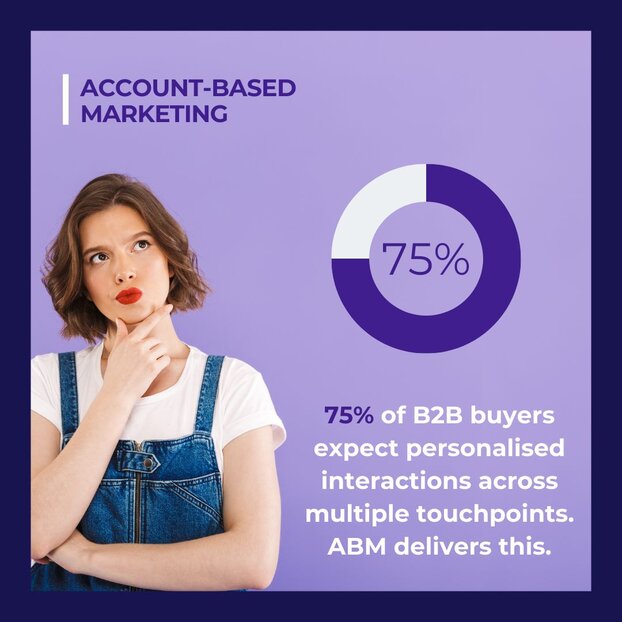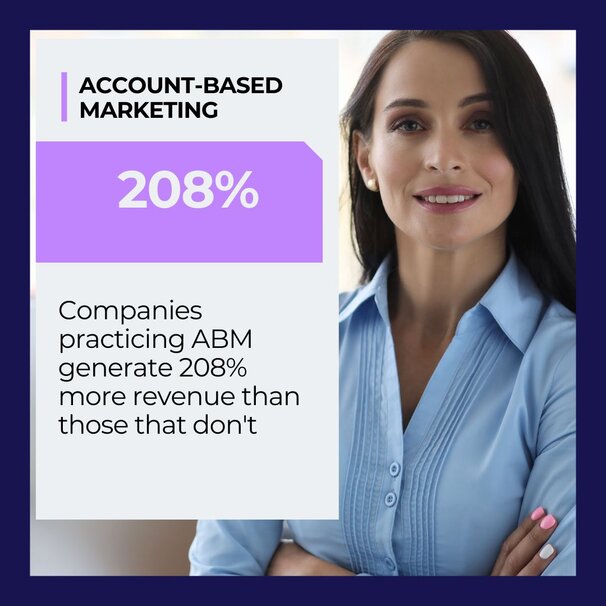ABM Marketing
Crafting Personalised Experiences that Drive B2B Success
Account-Based Marketing (ABM), focuses on delivering tailored experiences to high-value accounts. ABM flips the script on mass marketing by prioritising quality over quantity, ensuring that every interaction resonates deeply with the intended audience.
Let’s break down ABM into three key sections:
- The Core Frameworks of ABM
- The Three Tiers of ABM Strategies
- Executing ABM with Precision and Alignment
The Core Frameworks of ABM
Imagine you’re hosting a dinner party. But instead of throwing together a generic buffet, you meticulously craft a unique meal for each guest. Your vegan friend gets a gourmet plant-based dish, the steak lover is served a perfectly cooked ribeye, and the seafood enthusiast is treated to freshly shucked oysters. This bespoke experience makes your guests feel seen, valued, and appreciated. That’s exactly how ABM operates in marketing.
At its heart, ABM is about creating highly personalised, targeted campaigns for specific high-value accounts. It’s the antithesis of the spray-and-pray approach, focusing instead on quality interactions that drive deeper engagement and stronger relationships.

Why ABM Works
In the traditional lead-generation model, marketers aim to attract a broad audience and hope that a few will convert. ABM flips this model on its head by focusing on high-fit accounts from the outset. Here’s why it’s effective:
- Targeted Engagement: You’re not chasing random leads. Instead, you’re engaging with accounts that fit your Ideal Customer Profile (ICP).
- Deeper Personalisation: ABM allows marketers to craft messages and experiences that speak directly to the pain points and needs of each account.
- Stronger Relationships: By delivering value at every touchpoint, ABM fosters long-term relationships that go beyond the initial sale.
Tony Yang, CEO & Co-founder of RevOptica, puts it best: “In ABM, it’s not enough to know the company—you need to know the people. The key decision-makers, their challenges, and what keeps them up at night. That’s how you build meaningful connections.”
To build a successful ABM framework, start with the TEAM model:
- Target: Identify and prioritise high-value accounts.
- Engage: Deliver personalised, multi-channel experiences.
- Activate: Equip your sales team with insights to engage at the right time.
- Measure: Continuously track and optimise engagement to ensure success.
The Three Tiers of ABM Strategies
ABM isn’t a one-size-fits-all approach. Depending on your goals and resources, you can choose from three distinct tiers of ABM strategies: 1:1 ABM, 1:few ABM, and 1:many ABM. Each tier offers a different level of personalisation and scalability.
1:1 ABM – The White-Glove Treatment
Think of 1:1 ABM as the Michelin-starred experience of marketing. This approach is about delivering highly customised campaigns for a single account. It’s ideal for enterprise-level deals where the potential revenue justifies the investment.
Key Tactics:
- Tailored Content: Create case studies, videos, or microsites specifically for the account.
- Custom Offers: Provide unique demos or product configurations.
- High-Touch Sales: Collaborate closely with sales to nurture the relationship.
Example: A SaaS company targeting a global bank might build a dedicated microsite with resources tailored to the bank’s specific challenges and goals.
1:few ABM – The Goldilocks Approach
1:few ABM sits in the middle ground. It targets small clusters of accounts with similar challenges or goals, allowing for personalisation without stretching resources too thin.
Tony Yang shared a practical approach to 1:few ABM during a SaaS Stories podcast episode:
“In 1:few ABM, you’re not just personalising at the account level; you’re creating relevance for clusters of accounts that share common pain points. The trick is balancing scalability with meaningful engagement.”
Key Tactics:
- Clustered Targeting: Group accounts by industry, region, or business need.
- Personalised Campaigns: Create content that addresses shared challenges.
- Multi-Threaded Engagement: Engage multiple stakeholders within each account to drive decision-making.
1:many ABM – The All-You-Can-Eat Buffet
1:many ABM is about scaling personalised marketing efforts across a broad audience. While it lacks the deep personalisation of 1:1 or 1:few, it still focuses on relevant messaging.
Key Tactics:
- Industry-Specific Content: Create webinars or eBooks tailored to common industry challenges.
- Automated Campaigns: Use tools like HubSpot or Marketo to automate outreach.
- Personalisation at Scale: Segment your audience and deliver targeted messaging.
Executing ABM with Precision and Alignment
Crafting an ABM strategy is just the beginning. The real magic happens during execution. But here’s the catch—ABM isn’t a solo endeavour. It requires alignment across marketing, sales, and customer success teams.
As Rob Cassidy from Xsellerate emphasised on the SaaS Stories podcast:
“ABM is a team sport. You need marketing, sales, and customer success rowing in the same direction. Without alignment, your efforts fall flat.”
4 Steps to Successful ABM Execution
Kick-Off Meeting & Goal Setting:
- Bring marketing, sales, and customer success teams together to align on goals.
- Define your Ideal Customer Profile (ICP) and create a Target Account List (TAL).
Content Development & Gap Analysis:
- Audit existing content to identify gaps.
- Create personalised assets like case studies, whitepapers, and videos.
Campaign Launch & Tracking:
- Set up tracking to monitor account engagement.
- Use tools like Snitcher or 6sense to capture both first-party and third-party intent data.
Ongoing Optimisation:
- Regularly review engagement metrics.
- Adjust your strategy based on real-time data.
Key Metrics to Track in ABM
Unlike traditional marketing, ABM focuses on account-specific metrics. Here are a few to keep an eye on:
- Account Engagement Rate: How many target accounts are engaging with your content?
- Deal Velocity: How quickly are target accounts moving through the sales funnel?
- Multi-Threaded Engagement: Are you engaging multiple stakeholders within each account?
- Revenue from ABM Accounts: How much revenue is coming from your target accounts?

ABM Marketing for the Win
Account-Based Marketing is a shift in how B2B companies engage with their most valuable prospects. By focusing on quality interactions, ABM drives deeper relationships, faster deal cycles, and higher revenue.
Whether you’re delivering a Michelin-starred experience with 1:1 ABM, scaling your efforts with 1:few, or casting a wider net with 1:many, the key to success is personalisation, alignment, and continuous optimisation.
As Tony Yang aptly put it:
“It’s not about selling to companies; it’s about building relationships with people.”